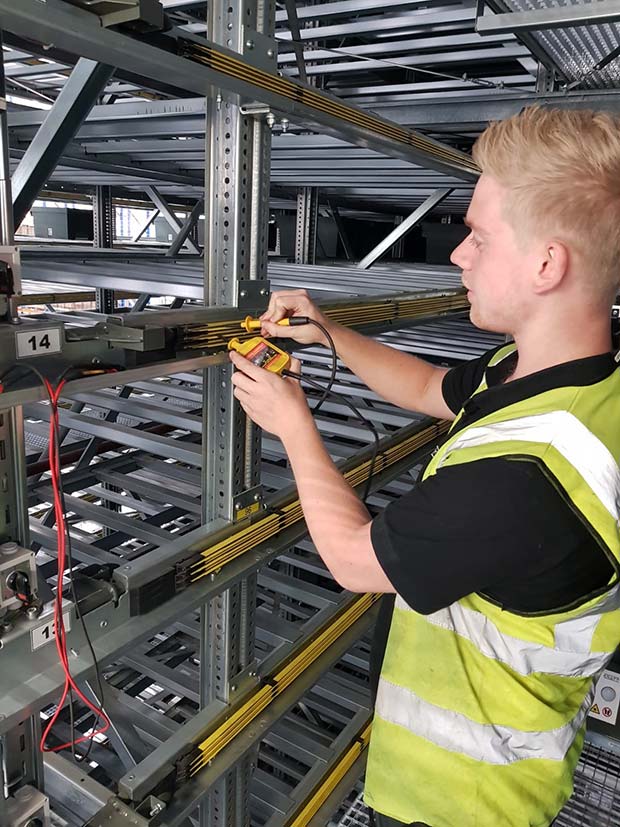As logistics operators navigate a path in the ‘new normal’, what will be the effect of challenging economic times on warehouse maintenance? Warehouse & Logistics News spoke to Nathan Billing, Customer Service Director for automated systems supplier, KNAPP UK, about the likely impact.

Customer Service Director for KNAPP UK
How has the pandemic affected your Customer Service operations?
There is no doubt that the pandemic has placed considerable stress on logistics operations for companies across the UK. Some warehouses – including those of a few of our clients – have had to ramp up operations rapidly to meet unexpected peaks, while other companies have had to deal with the problem of storing unsold inventory. Although we had some minor impact due to COVID-19, our resident teams were able to continue to support our customers. We even managed to redeploy some technicians during lockdown from client sites that were less busy to those facing e-commerce demand spikes.
How has warehouse maintenance evolved in recent years?
As warehouses became larger and more mechanised in the post-war era, the traditional model of ‘fix it when it breaks’ – which risks significant downtime if spare parts are not immediately available – gave way to the philosophy of preventative maintenance. Maintaining logistics equipment in a timely manner became vital in order to meet operational demands, maximise uptime and avoid unplanned disruption and costs. Rather than simply being performed according to a predetermined time schedule, preventative maintenance can be triggered by relevant data, such as recorded fault trends and feedback data via a SCADA (Supervisory Control And Data Acquisition) system on equipment runtime. So, just like modern cars, maintenance frequencies can be based on usage, rather than at set points. Although this move from being reactive to proactive represents a step forward, preventative maintenance is not a real-time activity. Often companies rely on spreadsheets of recent data to manage their maintenance rather than current data. Hence the trend towards predictive maintenance, using digitalized maintenance platforms that can provide visibility across systems, sites and even organisations through the Internet of Things (IoT).
Can you explain how predictive maintenance works?
With an IoT connection to each piece of materials handling equipment, sophisticated sensors can collect real-time data – such as motor speed, temperature changes and vibration levels – that may signal a problem. These sensors can pick up extremely subtle changes that may not be picked up by the eye or touch of a technician – even one with many years’ experience. You can think of these sensors as working in a similar way to the human nervous system when a medic is diagnosing a patient – data from each individual sensor is useful but when combined with data from all the other sensors, it gives a much better picture. Once transferred to a digitalized maintenance platform via the Internet, predictive analytics can be deployed to reveal patterns in the data that can be used – combined with historical data – to predict what will happen to various elements of the logistics system. Maintenance can then be targeted at the equipment that requires attention, rather than wasting time and money on scheduled maintenance routines. This predictive maintenance can also be enhanced by artificial intelligence, which makes the volume of data manageable and facilitates decision-making in maintenance operations.
What is resident maintenance and what impact do you think the pandemic will have on it?
With warehouses today often working 24/7 and warehouse equipment ageing daily, there can be significant stress on materials handling systems. Planning the maintenance required and the optimal time to perform it is no mean feat. For large or complex distribution centres, it can make sense to have a resident team of technicians based at the warehouse to deal immediately with any issues and ensure maximum system uptime. With narrowing delivery windows, this is often vital to delivering goods on time.
At KNAPP UK, we have 15 Resident Service Contract (RSC) customers today – including shoe retailer, Clarks, which gave us our very first contract back in 2006. These 15 sites are maintained by over 220 skilled technicians and all operate on an open-book accounting principle to provide customers with maximum transparency. Each contract is assigned a dedicated Key Account Manager to provide support for monthly financial and maintenance reporting, as well as service level agreement (SLA) and key performance indicator (KPI) reports. We offer 24/7 system cover, delivered both on site and remotely via a hotline to additional Customer Service experts at our headquarters in Graz, Austria. Using a Computerised Maintenance Management System, we provide a data-driven, proactive approach to service management that aims to deliver continuous improvement through clear management information via activities such as daily review meetings, KPI tracking and system availability analysis.
In terms of the impact of the pandemic, we think there will be increasing demand for resident services in certain sectors. In an economic downturn, competitive advantage – which is principally determined by price/cost and service level – is more important than ever for customer attraction and retention. Companies, especially those with e-commerce operations, will be even more mindful of the effect of downtime on their service levels. There may also be a desire by some companies to delay investment in new systems by prolonging the life of existing equipment, again making effective and timely maintenance vital.

What about non-resident maintenance services?
As well as resident teams, we provide field service support (for Visited Maintenance Contracts and Response Time Contracts), spare parts management and a range of value-added services – such as thermal imaging surveys, leak detection, condition-based monitoring, condition audits and inspections for racking, shelving, and LOLER (Lifting Operations and Lifting Equipment Regulations). We expect demand for these services to grow too, again as some firms seek to maximize the life of their existing equipment.
How will you keep up with growing demand for Customer Service?
As well as recruiting fully trained technicians to join our organisation, we grow our own talent through a four-year apprenticeship scheme that is operated in collaboration with automotive giant, Toyota. Our apprentices – we currently have four at various stages – learn at Toyota’s excellent training facility in Derby and at further education colleges, as well as on-the-job training within our resident teams.
Can you sum up the value of Customer Service?
Customer Service can be an important differentiator for us as a logistics solution provider. Along with technological innovation, it is forms a significant part of our reputation or – to use the buzzword – ‘brand value’. Of course, excellence in warehouse maintenance can also deliver competitive advantage to clients and, in this way, also becomes a differentiator for them. Win-win.
KNAPP UK
01865 965 000




Comments are closed.